 Black Rat
Black Rat 
AKA Roof Rat
Tracks and Sign
 Black Rat
Black Rat 
AKA Roof Rat
Tracks and Sign
Rattus rattus

Rat Tracks


 Natural History of Rats
Natural History of Rats

|
The black rat, or roof rat, (Rattus rattus) is commonly found in areas that have a mixture of country and city. They seem to prefer the more open, wild areas, rather than urban areas. The related Norway rat, or brown rat, (Rattus norvegicus) prefers urban areas and is frequently found in cities and other areas inhabitated by humans. Black rats are also called roof rats. In the black rat, the tail can be about 15% longer than the head and body length. In the Norway rat, the tail is shorter. These animals are both rodents. Rodent tracks typically show four toes on the front feet and five toes on the hind feet. Read on to learn more about rat tracks and sign! |
|
 |
|
| Black rat or roof rat trail in dust showing the hind tracks landing on top of the front tracks. This is a walking trail pattern due to wide straddle and the direct register of the hind tracks on top of the front tracks. You don't see clear imprints of the front tracks because the hind feet were placed on top of them, obliterating those tracks. | |
 |
|
| In this right hind
track, you can clearly see the six pads that make up the
"heel." These are called metatarsal pads and are named
for the bones which underlie them. Human feet have
metatarsal pads too! One characteristic of rat tracks is
that they have these six pads. Other species of wildlife
have different numbers of pads on their heels. Pads that
are closer to the animal's body are sometimes referred
to as proximal, while the pads further away from the
center of the animal's body are referred to as distal. |
|
 |
|
| This right hind track in dust also shows the six metatarsal pads that make up the hind foot heel. The three center toes - which are toes 2, 3, and 4, are usually grouped together as shown. This is characteristic of rodent tracks in general. The outer two toes, toe 1 and 5, sit off to the sides, also a rodent characteristic. | |
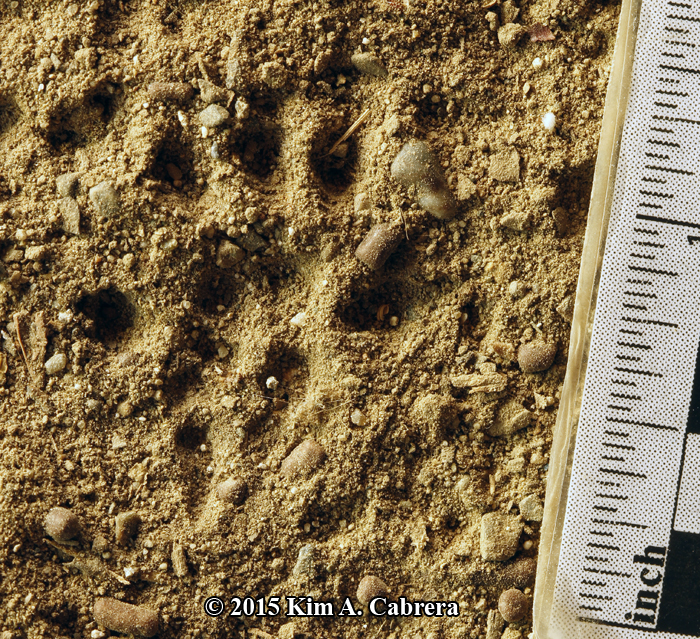 |
|
| Another right hind
rat footprint in dust. This one clearly shows all the
features, including the six metatarsal pads and the five
toes. Hind feet have five toes that leave imprints.
Front feet have five, but the inner toe, or toe 1, is so
small that it rarely leaves an imprint in the tracks.
This is true of other rodents as well, such as mice and
squirrels.On the hind feet, the two outer toes, toes
number 1 and 5, point almost 90 degrees out to the
sides. |
|
 |
|
| A left hind track in dust. Notice that toe 1, the one on the far right, is located lower on the footprint, which equates to further back in the foot itself. This is one clue that helps you tell left from right prints. | |
 |
|
| A left hind track superimposed on other tracks. | |
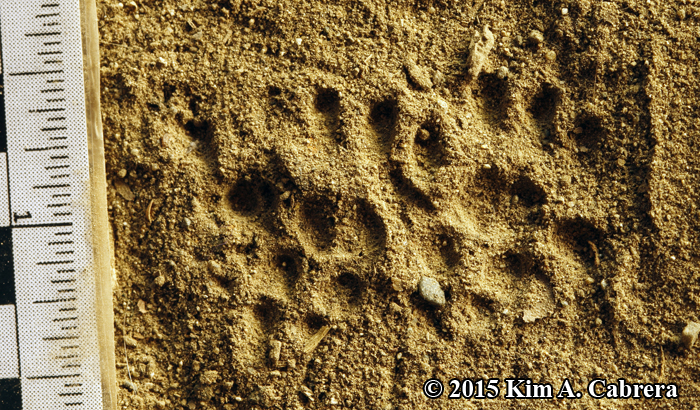 |
|
| Two right hind tracks side by side. Possibly two animals passed this way. Or one animal made several trips past this point. | |
 |
|
| A left hind track missing toe 5, or the outer toe. This could indicate an injury, or it could just be due to the substrate. Or another animal stepped here and obliterated the imprint of toe 5. You have to follow the trail for a bit to determine which is the case. In this case, it was another animal stepping there and erasing the imprint from toe 5. | |
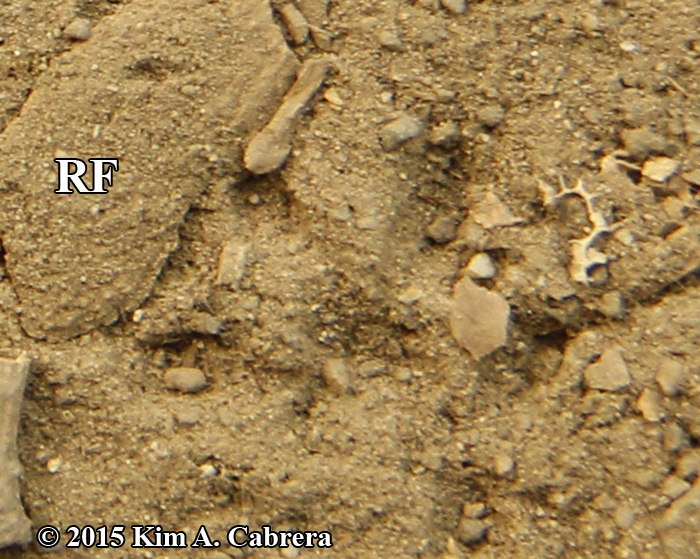 |
|
| A right front rat track in dust. The front tracks normally show four toes. Although there are five toes on the front feet, the inner toe is super small and rarely leaves an imprint. The inner toe is called vestigial because it's small and rarely found in tracks. You have to have nearly perfect mud or silt to see it. Dust is too coarse a substrate. | |
 |
|
| A rat trail pattern. Walking near the ruler, then speeding up into a trot above. Rats can use many gaits. | |
 |
|
| Close up view of the walking part of the trail above. Notice the wider spacing between the prints and the shorter length of the stride. | |
 |
|
| A beautiful right hind rat track. Notice
that the last of the six metatarsal pads looks longer
than the others? This can help you tell left from right.
If the track is complete, like this one, you will see
all the pads. That larger one is a good clue. It's
located to the inside of the foot, below toe 1. (In the
photo, it's closest to the RH.) The same is true is
squirrels. The longer of the metatarsal pads is located
on the inside of the foot. |
|
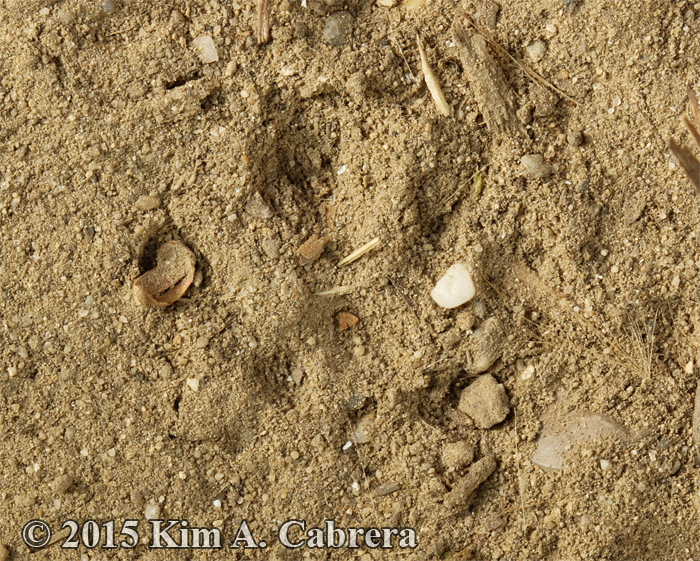 |
|
| Left front rat track in dust. Four toes show clearly. | |
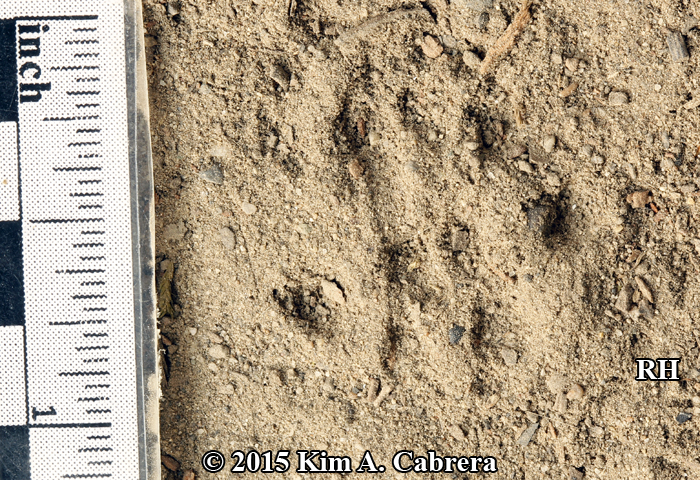 |
|
| Another right hind track. This one only shows four of the six metatarsal pads found on the heel. | |
 |
|
| Black rat, or roof
rat, scats. These were found inside a storage cabinet in
which the rat had eaten a plastic bottle. The bottle
contained oven cleaner! Rats can eat many things, even
those that seem inedible to us.They are known to chew on
plastic, the covering on wires, wood, cardboard, and
much more. Those gnawing teeth allow them to get into a
lot of things! |
|
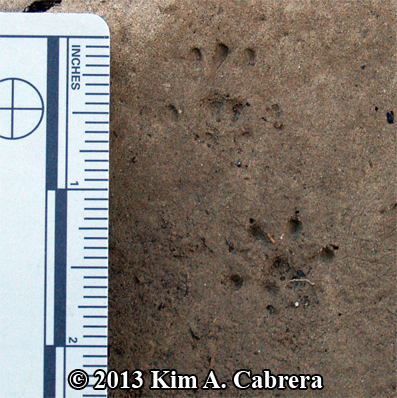 |
|
| Left front (below) and left hind (above) roof rat tracks in mud. | |
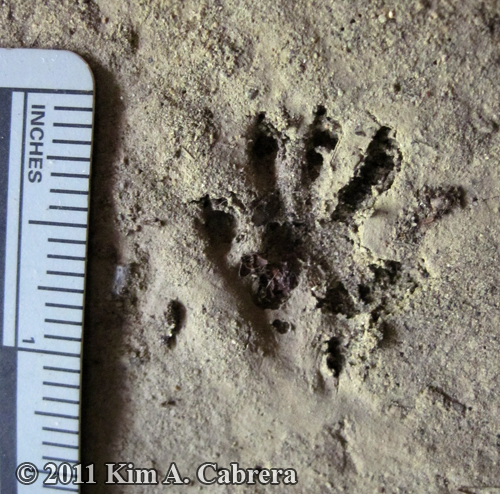 |
|
| The left hind track of a roof rat in deep mud. Notice that the toes are attached to the heel in this track. This is due to the substrate. Due to the curvature of a rat's fingers, you will normally only see the tips of the toes leaving an imprint. In this case, the mud was deep and the foot sunk into it. | |
 |
|
| A close up view of the rat
track seen in the photo above.Notice that the entire
length of the toe is visible in this track due to the
depth of the substrate. |
|
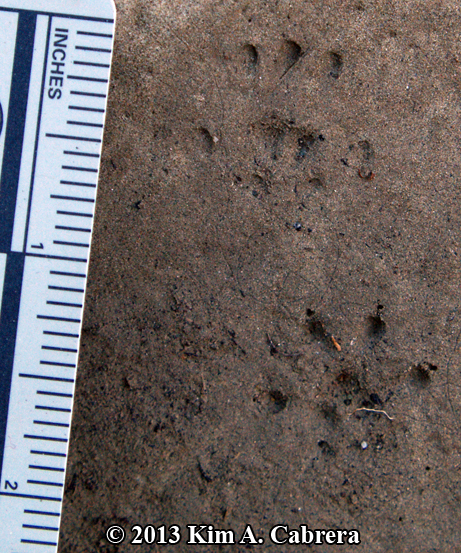 |
|
| Perfect rat tracks in mud. The left hind foot is above and the left front foot is below. Notice that the front foot shows four clear toe prints, while the hind shows five. These are characteristic rodent tracks. | |
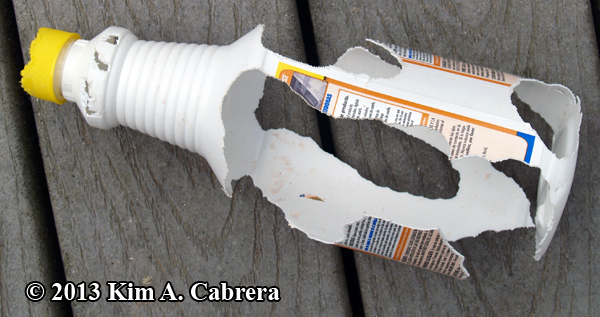 |
|
| Rats can be quite destructive. In this case, a rat chewed up and ate the plastic from a bottle of oven cleaner. I have no idea what nutritive value they derive from plastic, but they certainly do chew on it! They also will chew the plastic coating off wires, such as in your car's engine! | |
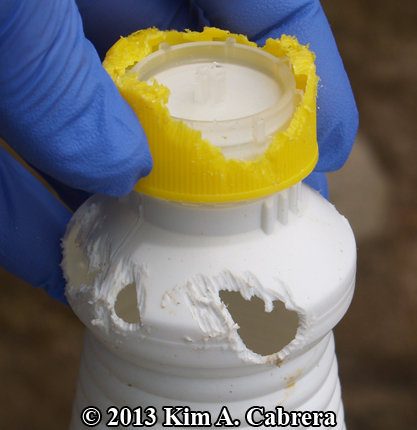 |
|
| A close up of the tooth marks of the rat on the plastic bottle. Notice that even the thicker lid was eaten! | |
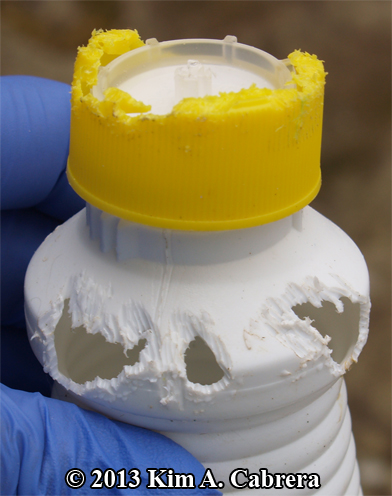 |
|
| Rat teeth are strong and sharp. It can't be easy to gnaw through hard plastic like that lid! | |
 |
|
| This close up allows you to see the paired tooth marks left behind by a rat. | |
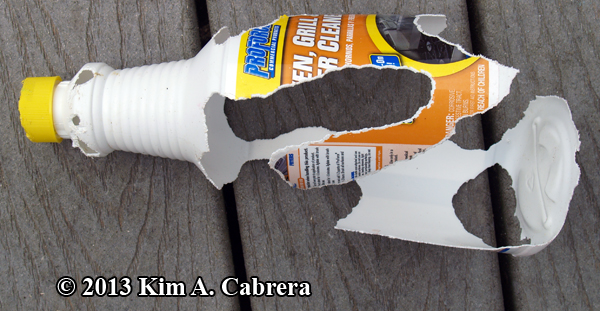 |
|
| I have no idea why the over cleaner did not affect the rat that ate this bottle. I think the liquid ran off when the bottle was dumped over, since the other items inside the cabinet were damp. However, I would think there'd be enough residue on the plastic that it would be toxic. It did not seem to affect the rat though! | |
|
|
|
|
| Black rats live near me in the woods. I have found their tracks in many places, such as on the dunes at the ocean and inland, underneath buildings. They seem to prefer a wide variety of habitats and survive quite well in places we think remote. I think they are quite intelligent. Rats are thought of as dirty animals, but are actually quite clean. They constantly groom themselves. However, they can leave behind quite a mess due to their sometimes-destructive feeding habits. This is why they've got such a bad reputation with humans! Not to mention that their fleas may have been responsible for some plague outbreaks in the past! |
Find rat posters, greeting cards, postage stamps and more in my new store.
|
Visit Beartracker's Nature Store
online store at: www.dirt-time.com
Happy tracking!! What else can you find in the nature store? Beartracker's T-shirts, sweatshirts, journals, book bags, toddler and infant apparel, mouse pads, posters, postcards, coffee mugs, travel mugs, clocks, Frisbees, bumper stickers, hats, stickers, and many more items. All with tracks or paw prints, or nature scenes. Custom products are available. If you don't see the track you want on the product you want, email me and I can probably create it. Proceeds from all sales go to pay the monthly fees for this web site. You can help support this site as well as get great tracking products! Thank you! |
| Find other tracking products: www.zazzle.com/tracker8459* |
| Also
visit these fine stores for more products of
interest:
NDN Pride shop - For Indian Pride items for all tribes. Custom items available on request. ASL Signs of Love - For anyone who uses or is learning ASL, American Sign Language. Custom name items and more are available here. Get Every Child Outdoors (Get E.C.O.) - My shop dedicated to nature and getting kids interested in nature and the outdoors. Sales from all stores give commissions to Beartracker's Animal Tracks Den, which helps keep this site online as a free service. We are celebrating ten years online this year! |
|
If you wish to help keep this site
online, donations are accepted through PayPal. |




Got a lizard story? E-mail me and tell me about it.
You are visitor number:
Copyright © 2015, 2018. Text, photos, and drawings by Kim A. Cabrera


Page updated: June 11, 2018